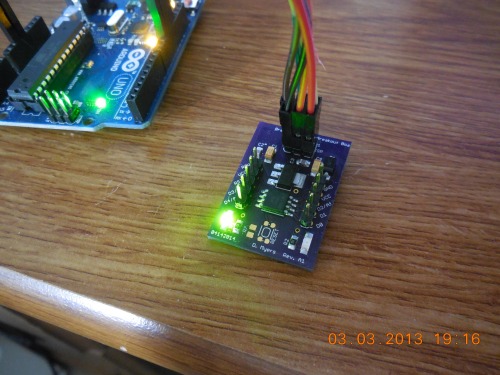My grandchildren are visiting for a month, as they always do during the summer, and when they arrived the youngest told me that he wanted to build a robot. How can you not love that?!?! He had some grand ideas abot what the robot should do, but in the end I convinced him that we should start simple. I suggested building a robot that chases light and he proclaimed that he wanted to build a moth, because they chase light.
So we began to design and build a moth robot (Mothbot). We turned to the web and downloaded some moth silhouettes and then, using a program called Inkscape, I converted the sillhouette into a dxf outline. The dxf files were imported into my CAM software (CAMBAM) and Gcode was produced.
Once we had the Gcode we moved to the CNC mill. I selected .0625 acrylic for the body because I have a bunch onhand. And we began cutting out the body.
Before anyone starts beating me up, I handed Luke the hose and went to get him some eye protection. When I turned around he had such a big grin on his face because we were building a robot and he was helping and I had to snap this photo.
When the basic shape was milled from the acrylic, we shaped the body using a fixture that I had made sometime ago. The fixture is made from MDF and a piece of aluminum channel. Nichrome wire provides the heat. I had to add the spring because the wire stretches so much when heated.
Using the fixture we bent the wings up at about a 30 degree angle. This gave the mothbot a little character.
For the brains I settled on one of my personal Attiny85 boards with a 3.3 Vdc regulator installed.
And here is where I messed up and did not get any picturs of the build process.
Above is a picture of the bottom of the robot. Notice the two encapsulated devices, each with 3 wires protruding from the ends. These are 2N2222 transistors with 270 ohm base resistors, for driving the motors, encapsulated in marine heat shrink. Marine heat shrink has an adhesive inside that melts as it shrinks to seal the wire/assembly.
The eyes on the front are LDRs with 1k resistors in series.
Above is the finished robot. It is powered by two 130 maH lipo batteries in series for a supply voltage of 7.4 Vdc. This voltage is fed to the RAW input of the controller board and directly to the motors.
The robot works ok, but my software requires some work. Sorry that there is no video, but I still have no way to capture video yet.
Luke is very proud of the robot that he and I made. He cannot wait for school to start so that he can take the robot to school for show and tell, and that makes it an awesome build for me!
This is a companion discussion topic for the original entry at https://community.robotshop.com/robots/show/mothbot








